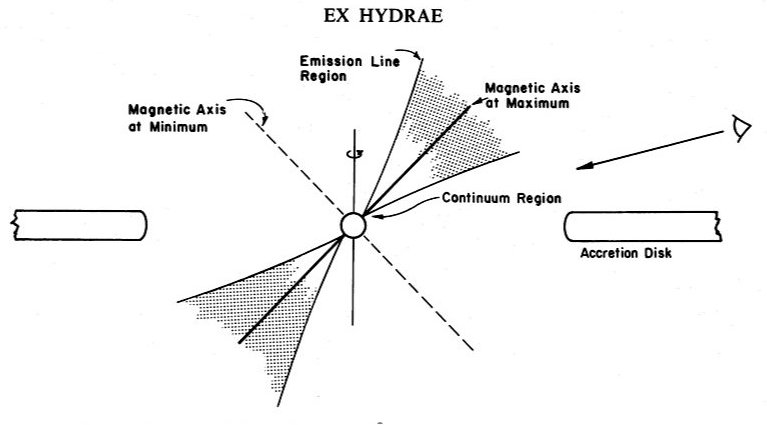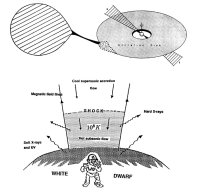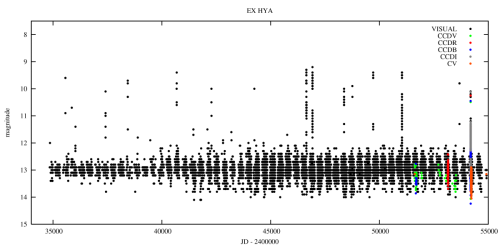Meet EX Hydrae
 |
| An artist's impression of an intermediate polar. (Image credit: Mark A. Garlick) |
Located at R.A. = 12m52h 24.2s Dec. = -29o 14' 56.0", EX Hydrae is a southern variable star classified as an eclipsing intermediate polar-type cataclysmic variable (CV). As a binary system with an orbital period of 98 minutes, EX Hya belongs to a small group of intermediate polars with ultrashort periods. This interesting variable also possess a 67-minute oscillation, believed to be the spin period of the white dwarf component. The distance to the variable is estimated at 65 pc (Eisenbart et al. 2002), making it one of the closest known CVs. The two stellar components are of mass M1 = 0.4 - 0.7 Msolar and M2 = 0.07 - 0.10 Msolar , while the inclination of the system is i = 76.0o - 77.6o (Beuermann et al. 2003). Outbursts of EX Hya are highly erratic, generally recurring every few of years or so, where the magnitude can vary from about 14.1 to 9.2. While much is known about EX Hya, much is yet to be learned.
Humble Beginnings
First mention of EX Hya was published over 50 years ago, when Dr. G.H. Herbig (then at the Lick Observatory) requested identification charts for 45 variables from astronomers at Harvard College Observatory. According to Herbig, stars included in the list "proved unidentifiable from the descriptions in existing literature" (Walker & Olmsted 1958). Shortly thereafter, the variable was studied spectroscopically by Kraft (1962, 1966), where EX Hya was seen to possess similar features to that of the well-known cataclysmic variable WZ Sge. Of particular interest were the doubled emission lines seen in the spectrum of EX Hya - a tell-tale sign of a nearly edgewise view of the binary in its orbital plane. A test of this hypothesis would be to look for eclipses in the light curve of the EX Hya.
 |
| Diagram of EX Hya showing the possible geometry of the system (Kaitchuck et al. 1987). |
W. Krzeminski was the first to identify EX Hya as an eclipsing binary with a 98.3 minute period (unpublished, but reported in Mumford 1964). Confirmation of the occurrence of eclipses was provided by Mumford (1964) who observed EX Hya photoelectrically in three colors in with the Kitt Peak 36-inch Cassegrain reflector and refined the period to 0.068233846 days, or 98.25696 minutes. Comparing light curves, Mumford found similarities between EX Hya and WZ Sge, but not with the CV dwarf nova subclass prototype, U Gem. "The latter star exhibits a pronounced shoulder prior to eclipse, and a more or less constant decrease in brightness amounting to a few hundreths of a magnitude following minimum until the onset of the shoulder once again. In EX Hydrae, the variations appear continuous, with little or no constant phase" (Mumford 1964). Further work by Warner (1972), however, revealed considerable photometric differences between EX Hya and WZ Sge. "EX Hya is a highly active object, with light variations of much greater amplitude than those seen in WZ Sge." A more exact CV subclassification, it seemed, would take further investigation.
An Unexpected Find
 |
| A closer look at EX Hya's short-term behavior. |
Continuing his study of EX Hya, Mumford (1971) monitored the variable over a 6-year interval and reported the orbital period as unchanged. However, later work by Vogt et al. (1980) covered a 14-year interval and revealed not only a decrease in orbital period, but also a surprising and unique 67-minute oscillation. Models to explain 67-min modulation include either modulated mass transfer produced by pulsations from the secondary or an intermediate polar model (Vogt et al. 1980; Warner & McGraw 1981). In the latter model, emission is beamed from the magnetic poles with the 67-minute oscillation the result of the rotation of the white dwarf. Looking at the spectrophotometry, Kaitchuck et al. (1987) reported that the source of the 67-minute period is close to the white dwarf but not in the disk. The model most consistent with this would be that of an intermediate polar. While Vogt et al. (1980) found stability in the 67-min variation over a interval of 14 years, Gilliland (1982) found a shortening on the time scale of 2.8 x 106 year.
Beyond the optical regime, EX Hya is also a source of hard and soft X-rays. In the 1970s, it was recognized as one of two confirmed hard X-ray emitters (2 -18 keV) from a list of 47 dwarf novae investigated by the Ariel V Sky Survey Instrument (Watson et al. 1978), which was followed by the HEAO-1 finding of soft X-ray emission (0.5 - 3 keV) (Cordova & Riegler 1979). When in optical quiescence, EX Hya continues to show relatively strong emission of both hard and soft X-rays (Watson et al. 1978; Cordova & Riegler 1979). "The intermediate polar model accounts in a natural way for the fact that EX Hya is a hard X-ray emitter even at minimum light. It has the added advantage that it places EX Hya in a class of star that is well known, whereas the modulated mass transfer model would make EX Hya unique" (Warner & McGraw 1981).
The Magnetic Cataclysmics
As mentioned, EX Hya is a cataclysmic variable. Cataclysmic variables are close binary systems containing a white dwarf star as the primary component and a low-mass main sequence star as the secondary. Due to evolutionary effects, the secondary star loses matter in the direction of the primary. Conservation of angular momentum prevents the relocated matter from falling directly on the primary, but rather forms a disk about the white dwarf. Viscous forces acting on the disk cause the orbiting material to lose angular momentum, thereby allowing the matter to spiral slowly inward toward the white dwarf. This process effectively converts gravitational potential energy into heat and radiation. The generally accepted outburst theory involves instabilities within the disk, which causes a rapid rate of accretion onto the surface of the white dwarf.
CVs may be classified further depending on such factors as amplitude and frequency of outburst. Within these subclasses, the systems can be divided into the non-magnetic and the magnetic variables. As the name implies, magnetic CVs possess significant magnetic fields, which alter the disk structure depending on the field strength:
Polars (AM Her stars) - Polars, also called AM Her stars after the prototype of the class, are known for the magnetic fields associated with the white dwarf component. The field is so strong that it disrupts disk formation. Instead, matter is picked up near the mass-losing star and is funneled onto one or both of the white dwarf magnetic poles via the magnetic field lines. As a result, accretion columns are formed - a region of hard and soft X-ray emission. The strong magnetic field also forces the white dwarf into synchronous rotation with the orbital motion.
 |
| Diagram of an intermediate polar and its regions of emission (Patterson 1994). |
Intermediate Polars (DQ Her stars) - As the name implies, intermediate polars are a class between the magnetic AM Her systems and the non-magnetic CVs. Also referred to as DQ Her stars - named for the prototype of the class - intermediate polars possess weaker magnetic field strengths than the AM Her stars. As a result, partial disk formation occurs, but is disrupted at the point where the magnetosphere becomes dominant. Unlike the AM Her stars, the magnetic field is not strong enough to synchronize the white dwarf and orbital rotation; the white dwarf period is generally faster than the orbital rotation. In the accretion column region of the intermediate polar, most of the gravitational energy is released as a standing shock close to the surface of the white dwarf. The result is the emission of hard and soft X-rays. From a historical standpoint, DQ Her remained in a class of its own for 24 years before another intermediate polar (AE Aquarii) was discoverd. EX Hya was only the third confirmed DQ Her-type star (Patterson 1994; also see this reference for a review of the DQ Her stars).
For a look at the dwarf nova, nova-like, and recurrent nova non-magnetic CVs, check out our articles in the Variable Star of the Month/Season archive.
A Look at EX Hydrae's Light Curve
There are over 31,000 observations of EX Hya in the AAVSO International Database dating back to 1954. The records indicate that the outbursts of EX Hya are rather erratic and vary within wide limits: one outburst recurred within just days of the previous outburst, and another in just under a year. More commonly, however, outbursts recur every several years or so. Outbursts are relatively quick, rising about 2-3 magnitudes, and last only days at a time. As a consequence, observations of EX Hya during outburst have been historically rare and have lacked extensive coverage. According to the AAVSO International Database, at least 15 outbursts have been detected in the past 50 years. With such a short outburst duration though, some may have been missed in the seasonal gaps. The most recent outburst occurred in 2007, which was well monitored by AAVSO observers. The next outburst of EX Hya could literally be any day, month, or year now.
 |
| The AAVSO light curve of EX Hya. |
Observe EX Hydrae
 |
| Without constant monitoring, rare "double" outbursts such as the 1986 event may go unnoticed. |
EX Hya is one of the best studied intermediate polar variables, though AAVSO data for EX Hya has become rather sparse in recent years. Continued and increased monitoring through all phases of activity - from quiescence to outburst - is crucial to our understanding of this interesting variable. EX Hya is an important star, and frequent (even nightly) observations are encouraged. Since outbursts are relatively rare and short-lived, visual and CCD observers should monitor the star every 5 minutes for as long as possible during outburst, i.e., when the star is brighter than magnitude 12.0. Customized finder charts complete with a comparison star sequence may be plotted through the AAVSO Variable Star Plotter.
As an added incentive, EX Hya has been the subject of collaborative multiwavelength campaigns with numerous telescopes and satellites from X-ray to infrared. Observers may wish to be alerted of any special observing campaigns or of any activity by joining one of AAVSO's several email lists.
For further reading
- Beuermann, K., Harrison, T.E., MacArthur, B.E., Benedict, G.F., & Gansicke, B.T., 2003, "A Precise HST Parallax of the Cataclysmic Variable EX Hydrae, its System Parameters, and Accretion Rate," A&A 412, 821
- Cordova, F.A., & Riegler, G.R., 1979, "The HEAO-A2 Soft X-ray Survey of Cataclysmic Variable Stars - EX Hydrae During Optical Quiescence," MNRAS 188, 103
- Eisenbart, S., Beuermann, K., Reinsch, K., & Gansicke, B.T., 2002, "Multi-wavelength Spectrophotometry of EX Hydrae," A&A 382, 984
- Gilliland, R.L., 1982, "EX Hydrae - Physical Parameters Derived from Simultaneous Spectroscopy and Photometry," ApJ, 258, 576
- Kaitchuck, R.H., Hantzios, P.A., Kakaletris, P., Honeycutt, R.K., & E.M. Schlegel, 1987, "Time-resolved Spectrophotometry of the Cataclysmic Variable EX Hydrae," ApJ 317, 765
- Kraft, R.P., 1962, "Binary Stars among Cataclysmic Variables. I. U Geminorum Stars (dwarf Novae).," ApJ 135, 408
- Kraft R.P., 1966, "The Problem of Ultra-short Period Binaries," Transactions of the International Astronomical Union 12B, 519
- Mumford, G.S., 1964, "The Color Variation of EX Hydrae," PASP 76, 57
- Mumford, G.S. ,1971, 'Binary Stars among Cataclysmic Variables. XII. Photoelectric Observations from the Southern Hemisphere," ApJ 165, 369
- Patterson, J., 1994, "The DQ Herculis Stars," PASP 106, 209 [Invited Review Paper]
- Vogt, N., Krzeminski, W., & Sterken, C., 1980, "Periodic and Secular Variations in the Lightcurve of Dwarf Nova EX Hydrae," A&A 85, 106
- Walker, A.D., & Olmsted, M. ,1958, "Identification Charts for 42 Variable Stars," PASP 70, 495
- Warner, B., 1972, "Observations of Rapid Blue Variables - VII. EX Hydrae," MNRAS 158, 425
- Warner, B., & McGraw, J.T., 1981, "EX Hydrae - Modulated Mass Transfer or Intermediate Polar," MNRAS 196, 59
- Watson, M.G., Sherrington, M.R., & Jameson, R.F., 1978, "'Hard' X-ray Emission from Dwarf Novae," MNRAS 184, 79
This AAVSO Variable Star of the Season article was written by Kerri Malatesta.

